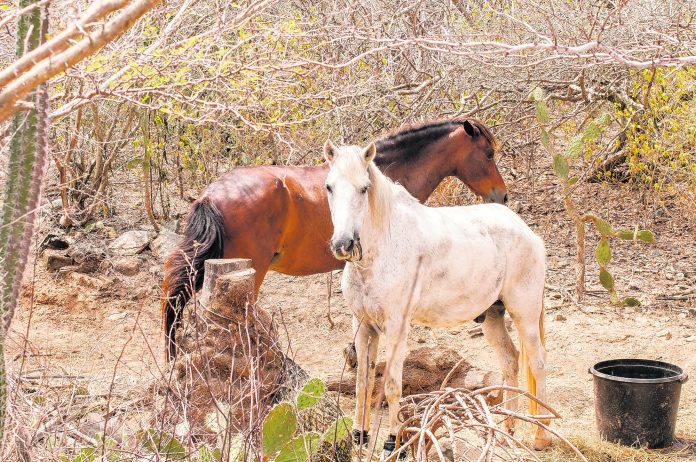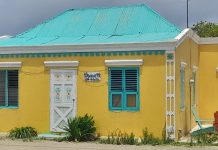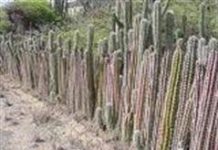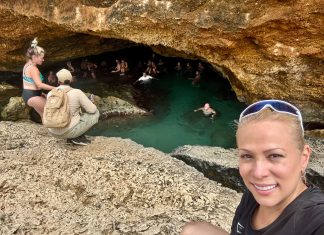Aruba has one special horse sanctuary and it started with a Holy Communion gift decades ago. The stead is an effort by Frederique Drost, her husband Oliver de Jong and their children. Together they founded the Equine Sanctuary Aruba, ESA, which is called Faye Ranch. The ranch is dedicated to the rescue of weak, sick, and even mistreated horses.
“The name Faye is based on where we lived before moving permanently to Aruba. We lived in Houston, on Faye Road. There, I worked with a horse sanctuary as well,” Drost explains. Drost was born and raised in The Netherlands and was always interested in horses. Her parents gave her first horse, a pony, on her Communion Day. But Parinka, as she called her pony, was to be shared with her younger sibling. She got her own horse when she was a little older and called it Lightfeet, which is the name of the horse in the popular Dutch children series book Arendsoog (Eagle’s Eye). Since then, Frederique dedicated her life to the care of horses and has over 40 years of working directly with horses and other equines.
Her husband’s work allowed family De Jong/Drost to travel around the world, visiting Aruba once before. After Houston they decided to return to Aruba and bought their home close to the Arikok National Park. The location and spacious property was exactly what the family was looking for to realize their next plans. Frederique was always set on having a horse sanctuary on the island.
The initial work was hard. Husband and children all helped in creating pathways in the thorny acasia tortuosa or as it is known, the Hubada tree which is abundant in the area. The family ensured to create shady spaces and enough safe areas for injured horses to move around and hide from the sun. The first two horses that arrived at Faye Ranch were Olympia and Rocky. Frederique always looks first at the legs and hooves of the horses and in the case of Olympia she was unfortunately too far gone. Her pain was unbearable and she had to be euthanized. Rocky luckily has improved and is now accompanied by Prince. “Faye Ranch cannot take more than four horses at the same time. That is the maximum number for the space we have,” says Drost.
Why the hooves.
Drost is a specialist in equine hoof care. However, unlike most farriers who do also the trimming and balancing of horses hooves, she does not believe in the need of iron shoes. In fact she wonders whether people understand the damage a horse shoe does to the health of a horse or any other equine, like donkeys, particularly, if the hooves are not regularly trimmed. “Hooves are more important to the animal’s health than most people realize. Iron shoes do not only weaken the hooves but also affect the nerves connected to the feet. Because of the iron shoes horses do not get to feel the ground or floor. And as a result, most develop arthritis or other issues that cause lots of pain and suffering.”
Drost assures that a horse or a donkey for that matter do not need iron shoes. “Their hooves are made of keratin, the same as human nails. And like nails, hooves grow. But natural movement keeps the growth under control. This explains why donkeys and horses need big spaces to roam around and thus keep their hooves under control in a natural way.” A horse needs to walk at least 16 kilometer a day in order for its hoof not to grow too much and become a problem she says. “A hoof is like a nail but one that is needed to hold up the weight of the animal. An iron shoe is like an acrylic layer on the natural nail. This means that like with human nails this unnatural material will debilitate the nail or in this case, the hooves.” Moreover, an iron shoe can even take away the stability of a horse. Horses can easily lose their footing because of the iron shoes, which contribute to the animals experiencing 800 times more impact when walking.
Horseback riding.
Frederique encourages horseback riding tours on the island as it is one way to get the animals out walking. She urges the ranches however to take the time of the day into consideration to avoid harsh sun. “And they truly should focus on the care of legs and the hooves. Take care of the wellbeing of the animal. Ideally, remove the iron shoes to avoid slipping and the negative physical impact.”
With a little help.
The work at Faye Ranch is substantial. Trimming and healing deformed hooves is not easy as horses do not always cooperate. Drost keeps a log on everything she does and photographs the development of the hooves. Currently she is getting the help of one or two volunteers and despite their willingness the island’s veterinarians are not specialized in this type of work. She also receives support from the Wit Gele Kruis (White Yellow Cross), which is a foundation that is specialized in providing care at home. She gets lots of materials she needs for the horses from them. Other than that the entire operation is financed by the family. The hope is to get more support. “We put the manure available for gardeners to pick up, in exchange for either apples and/or carrots to feed the horses.”
Faye Ranch is about more than just caring mistreated horses. The goal is to educate the entire community on the care of horses and therefore the ranch welcomes school children to visit. This way children can appreciate the value of caring for animals and learn about the importance of providing equines the necessary natural space. Also it is quite clear that the effects of horses on humans can be major. “A horse can provide tranquility and I have noticed this with a youngster who used to come and help here at the ranch. The boy was restless and could not attend school because of anxiety issues. His family and I saw a change in demeanor. The horses responded to him in a way that made him feel much calmer.” And even though Faye Ranch is not directed towards people in the Autism Spectrum Disorder (ASD), children with this disorder who can deal with animals are more than welcome,” Drost continues.
The ranch is another project that enriches Aruba and illustrates that the island is a place where care and love can be offered to the most vulnerable, including horses who need more attention. The family strives to be sustainable and promote the use of local vegetation to provide food and shade to the horses who roam the property thanks to carefully placed food and water. Faye Ranch is a haven for Rocky and Prince and also for local, colorful singing birds who at the same time control the fly population. q
For more information and volunteering at Faye Ranch, visit the Facebook page Faye Ranch. For donations, visit equinesanctuary.weebly.com

















